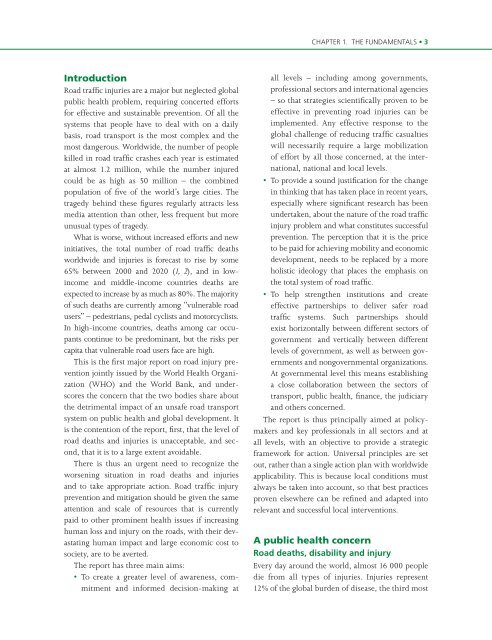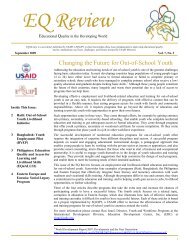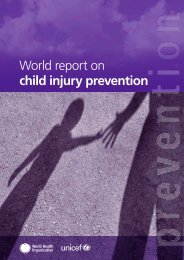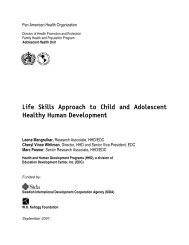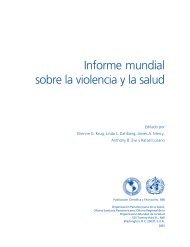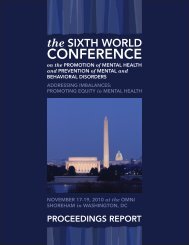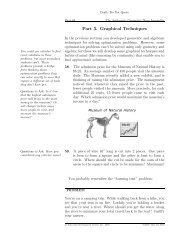World report on road traffic injury prevention edited by M ... - teach-vip
World report on road traffic injury prevention edited by M ... - teach-vip
World report on road traffic injury prevention edited by M ... - teach-vip
Create successful ePaper yourself
Turn your PDF publications into a flip-book with our unique Google optimized e-Paper software.
CHAPTER 1. THE FUNDAMENTALS • 3<br />
Introducti<strong>on</strong><br />
Road <strong>traffic</strong> injuries are a major but neglected global<br />
public health problem, requiring c<strong>on</strong>certed efforts<br />
for effective and sustainable preventi<strong>on</strong>. Of all the<br />
systems that people have to deal with <strong>on</strong> a daily<br />
basis, <strong>road</strong> transport is the most complex and the<br />
most dangerous. <str<strong>on</strong>g>World</str<strong>on</strong>g>wide, the number of people<br />
killed in <strong>road</strong> <strong>traffic</strong> crashes each year is estimated<br />
at almost 1.2 milli<strong>on</strong>, while the number injured<br />
could be as high as 50 milli<strong>on</strong> – the combined<br />
populati<strong>on</strong> of five of the world’s large cities. The<br />
tragedy behind these figures regularly attracts less<br />
media attenti<strong>on</strong> than other, less frequent but more<br />
unusual types of tragedy.<br />
What is worse, without increased efforts and new<br />
initiatives, the total number of <strong>road</strong> <strong>traffic</strong> deaths<br />
worldwide and injuries is forecast to rise <strong>by</strong> some<br />
65% between 2000 and 2020 (1, 2), and in lowincome<br />
and middle-income countries deaths are<br />
expected to increase <strong>by</strong> as much as 80%. The majority<br />
of such deaths are currently am<strong>on</strong>g “vulnerable <strong>road</strong><br />
users” – pedestrians, pedal cyclists and motorcyclists.<br />
In high-income countries, deaths am<strong>on</strong>g car occupants<br />
c<strong>on</strong>tinue to be predominant, but the risks per<br />
capita that vulnerable <strong>road</strong> users face are high.<br />
This is the first major <str<strong>on</strong>g>report</str<strong>on</strong>g> <strong>on</strong> <strong>road</strong> <strong>injury</strong> preventi<strong>on</strong><br />
jointly issued <strong>by</strong> the <str<strong>on</strong>g>World</str<strong>on</strong>g> Health Organizati<strong>on</strong><br />
(WHO) and the <str<strong>on</strong>g>World</str<strong>on</strong>g> Bank, and underscores<br />
the c<strong>on</strong>cern that the two bodies share about<br />
the detrimental impact of an unsafe <strong>road</strong> transport<br />
system <strong>on</strong> public health and global development. It<br />
is the c<strong>on</strong>tenti<strong>on</strong> of the <str<strong>on</strong>g>report</str<strong>on</strong>g>, first, that the level of<br />
<strong>road</strong> deaths and injuries is unacceptable, and sec<strong>on</strong>d,<br />
that it is to a large extent avoidable.<br />
There is thus an urgent need to recognize the<br />
worsening situati<strong>on</strong> in <strong>road</strong> deaths and injuries<br />
and to take appropriate acti<strong>on</strong>. Road <strong>traffic</strong> <strong>injury</strong><br />
preventi<strong>on</strong> and mitigati<strong>on</strong> should be given the same<br />
attenti<strong>on</strong> and scale of resources that is currently<br />
paid to other prominent health issues if increasing<br />
human loss and <strong>injury</strong> <strong>on</strong> the <strong>road</strong>s, with their devastating<br />
human impact and large ec<strong>on</strong>omic cost to<br />
society, are to be averted.<br />
The <str<strong>on</strong>g>report</str<strong>on</strong>g> has three main aims:<br />
• To create a greater level of awareness, commitment<br />
and informed decisi<strong>on</strong>-making at<br />
all levels – including am<strong>on</strong>g governments,<br />
professi<strong>on</strong>al sectors and internati<strong>on</strong>al agencies<br />
– so that strategies scientifically proven to be<br />
effective in preventing <strong>road</strong> injuries can be<br />
implemented. Any effective resp<strong>on</strong>se to the<br />
global challenge of reducing <strong>traffic</strong> casualties<br />
will necessarily require a large mobilizati<strong>on</strong><br />
of effort <strong>by</strong> all those c<strong>on</strong>cerned, at the internati<strong>on</strong>al,<br />
nati<strong>on</strong>al and local levels.<br />
• To provide a sound justificati<strong>on</strong> for the change<br />
in thinking that has taken place in recent years,<br />
especially where significant research has been<br />
undertaken, about the nature of the <strong>road</strong> <strong>traffic</strong><br />
<strong>injury</strong> problem and what c<strong>on</strong>stitutes successful<br />
preventi<strong>on</strong>. The percepti<strong>on</strong> that it is the price<br />
to be paid for achieving mobility and ec<strong>on</strong>omic<br />
development, needs to be replaced <strong>by</strong> a more<br />
holistic ideology that places the emphasis <strong>on</strong><br />
the total system of <strong>road</strong> <strong>traffic</strong>.<br />
• To help strengthen instituti<strong>on</strong>s and create<br />
effective partnerships to deliver safer <strong>road</strong><br />
<strong>traffic</strong> systems. Such partnerships should<br />
exist horiz<strong>on</strong>tally between different sectors of<br />
government and vertically between different<br />
levels of government, as well as between governments<br />
and n<strong>on</strong>governmental organizati<strong>on</strong>s.<br />
At governmental level this means establishing<br />
a close collaborati<strong>on</strong> between the sectors of<br />
transport, public health, finance, the judiciary<br />
and others c<strong>on</strong>cerned.<br />
The <str<strong>on</strong>g>report</str<strong>on</strong>g> is thus principally aimed at policymakers<br />
and key professi<strong>on</strong>als in all sectors and at<br />
all levels, with an objective to provide a strategic<br />
framework for acti<strong>on</strong>. Universal principles are set<br />
out, rather than a single acti<strong>on</strong> plan with worldwide<br />
applicability. This is because local c<strong>on</strong>diti<strong>on</strong>s must<br />
always be taken into account, so that best practices<br />
proven elsewhere can be refined and adapted into<br />
relevant and successful local interventi<strong>on</strong>s.<br />
A public health c<strong>on</strong>cern<br />
Road deaths, disability and <strong>injury</strong><br />
Every day around the world, almost 16 000 people<br />
die from all types of injuries. Injuries represent<br />
12% of the global burden of disease, the third most


